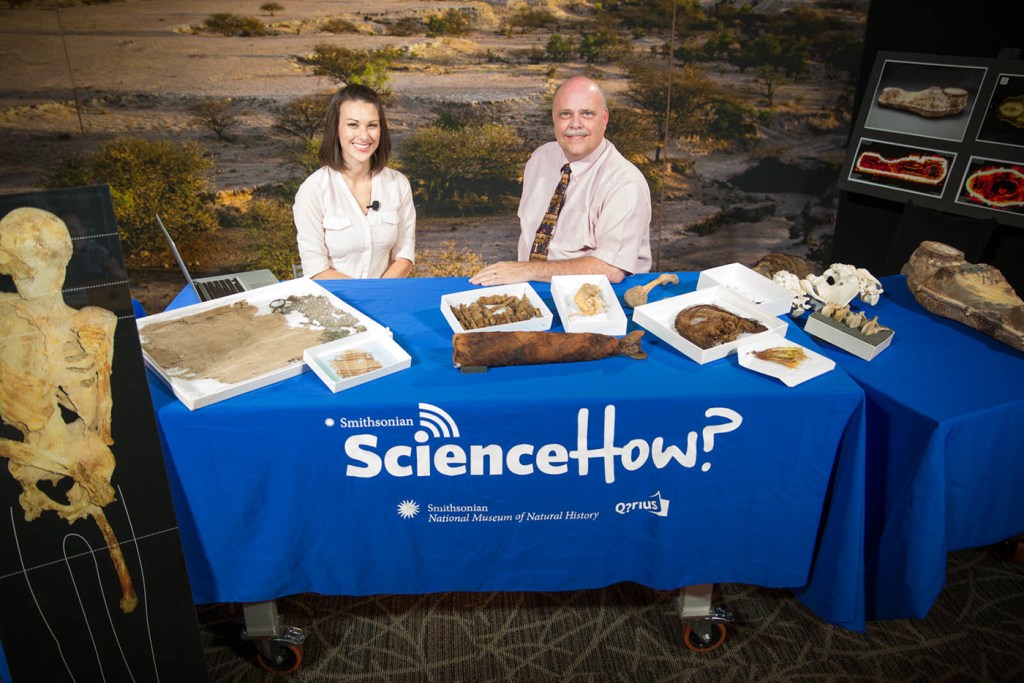Alumna hosts, produces popular science show for middle school students nationwide

Maggy Benson, S’06, has always loved nature.
As a kid, she would trudge through the creek running through her backyard in northeastern Pennsylvania, capturing worms, frogs, and caterpillars. She would build forts with sticks, sip tea while sitting on tree stumps, and amble through the woods, inspecting plants, insects, and rocks. She knew where the wildflowers bloomed. She knew where the crawfish hid. And she knew that exploring the great outdoors would be one of the highlights of her day, her week, her childhood.
“I was encouraged to be outside and explore the natural world around me,” Benson recalls. As she told one blog, “My mom had one rule: stay outside unless you’re bleeding or broken.”
Science How
Small wonder Benson is now the host and producer of Smithsonian Science How, a live, half-hour webcast aimed at introducing middle school students to the research and personalities of the Smithsonian’s National Museum of Natural History. And while Benson long believed that she would grow up to become a medical doctor or research scientist, she says, “I always thought I’d be contributing to science in a meaningful way, and now I get to help kids understand and appreciate the natural world.”
Some 6,500 middle school students nationwide tuned in to Science How’s season three premiere last month, an episode featuring a paleontologist who explained how dinosaurs rose to prominence approximately 200 million years ago. The next episode—culture and climate change in the arctic with famed archeologist Bill Fitzhugh—will be streamed live on Thursday, Nov. 5, at 11 a.m. and 2 p.m.
Benson’s preparation for each episode—which dovetails with national science standards and includes a comprehensive array of teaching resources—is extensive. First, she and a fellow content developer meet with the featured scientist, teasing out his or her most exciting research and discoveries. Then she reads up on the given topic, whether it’s bird extinctions, early human diets, or deep reef biodiversity, paying particular attention to the expert’s published books and peer-reviewed papers. Finally, she helps to pen the script, which includes poll questions for the fledgling scientists watching from the comfort of their classrooms. A sample question from the season three premiere: What major event happened on Earth 200 million years ago? A) Massive flooding, B) Huge volcanic eruptions, C) Asteroid hit, D) Dramatic climate change.
Benson leaves time at the end of each episode for a real-time Q&A, a crucial component of the program that, she says, “keeps students’ engagement level up and allows them to have a voice in the show.” To her, “A big piece of Science How is getting students to envision themselves in science, technology, engineering, and math careers, and breaking down the barriers between the perception and the reality of what the life of a scientist is like.”
My mom had one rule: stay outside unless you’re bleeding or broken.
—Maggy Benson, S’06
The art of science communication
Benson might not have become the face of Science How had it not been for Northeastern University’s co-op program.
After “falling in love” with ecology in class, she started working on co-op as an outreach assistant for Northeastern’s Marine Science Center. As part of her job, she introduced scores of young students to intertidal ecology and oceanography, familiarizing them with the ins and outs of the world-class research taking place at the facility.
“I credit my experience at the MSC for my being in science communication and education,” says Benson, who studied biology at Northeastern. “Understanding current research and being able to translate it for students was really invigorating,” she adds. “Seeing the excitement on their faces was gratifying, and knowing I had the power to inspire them to go forward and learn more about science was pretty special.”
As host of Science How, Benson challenges herself to inspire the tens of thousands of students who tune in to her show each school year. And she knows that it’s important for her to make a positive impression, particularly because of the nation’s current education crisis in the STEM fields. According to the National Math + Science Initiative, considerably less than 50 percent of 2013 U.S. high school graduates were ready for college-level courses in math and science.
“Our goal is the transform students’ connections with science,” Benson explains. “By conveying my own excitement about the field, I hope to inspire the next generation of scientists.”




